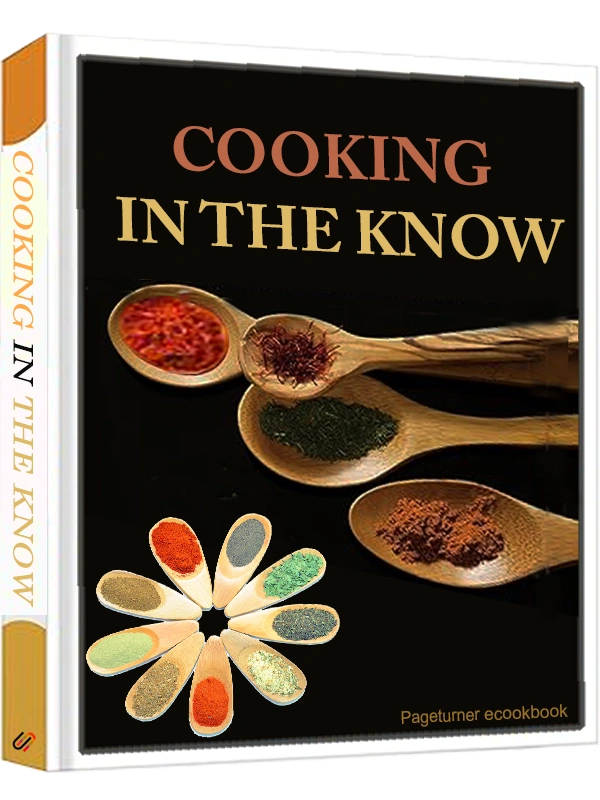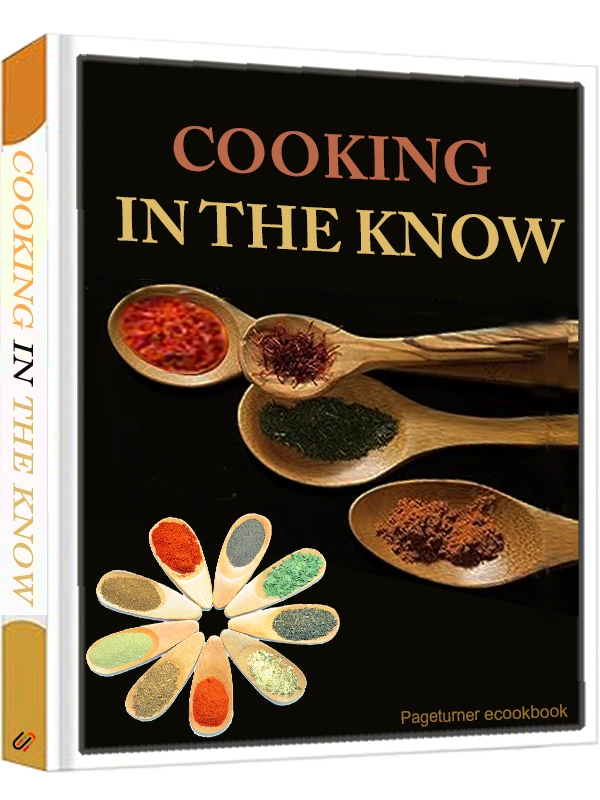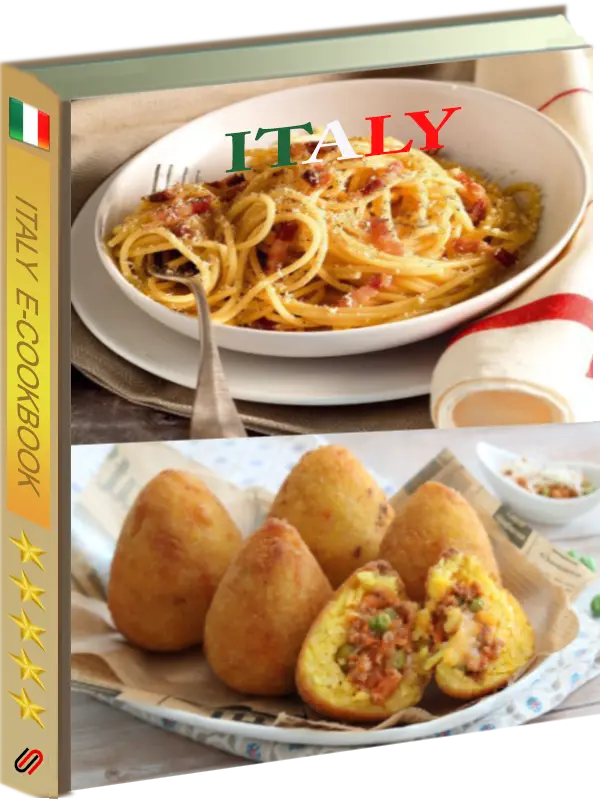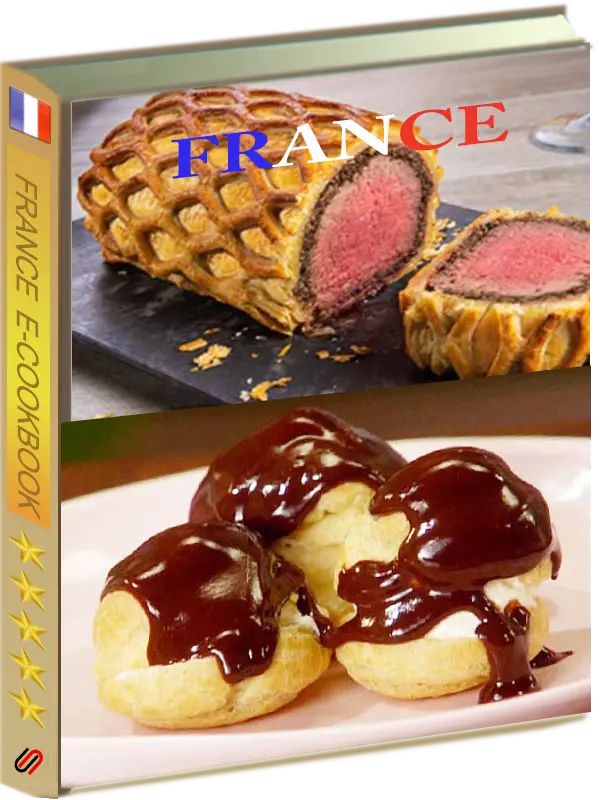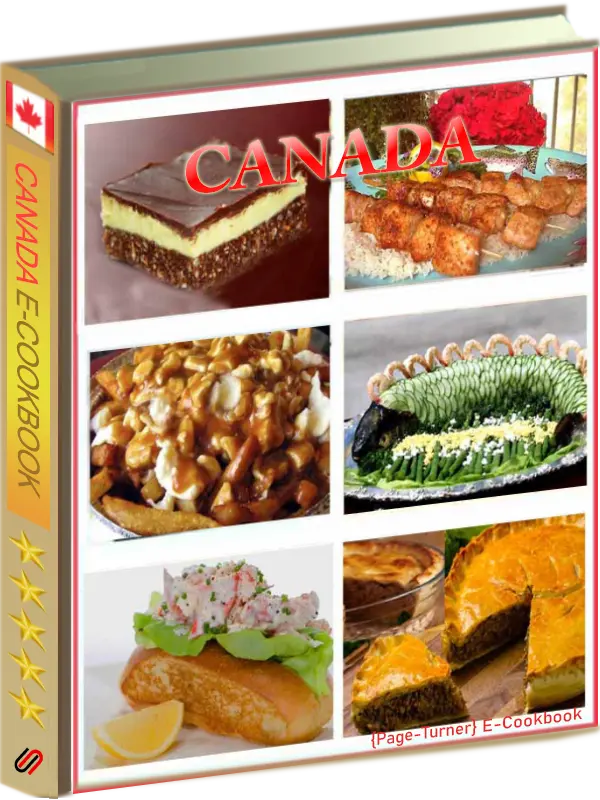If you love all things Cooking In The Know
this {Pageturner book} is for you
Best PLace To Keep Onions

Brown rice

Tips for successful cookies

Processed Meats

Is It Safe to Cook With Wooden Spoons?

Canned foods

how do yooose the right cooking oil?

About garlic

Grate butter for easy spreading

How can I tell if baking powder is still good?

How do mushrooms obtain their food?

bad smell of cauliflower

Garlic and Lemon

Flaxseed oil and broccoli

What is clarified butter? What is ghee?

liquid Measures
Weight & temperature Measures
non-liquid ingredients
Top 5 countries
Last Page

Brown rice

Tips for successful cookies

Processed Meats

Is It Safe to Cook With Wooden Spoons?

Canned foods

how do yooose the right cooking oil?

About garlic

Grate butter for easy spreading

How can I tell if baking powder is still good?

How do mushrooms obtain their food?

bad smell of cauliflower

Garlic and Lemon

Flaxseed oil and broccoli

What is clarified butter? What is ghee?

liquid Measures
Weight & temperature Measures
non-liquid ingredients
Top 5 countries
Last Page
Tips for successful cooking


The {Cooking In The Know} is an innovative guide for cooks and chefs to elevate knowledge and creativity.
Cooking has undergone a historic transformation:
With the advent of the global availability of ingredients, dishes based on geography and flavor this radical shift calls for a new approach to cooking -- as well as a new genre of {Cooking In The Know} that serves to inspire the creation of new dishes based on knowledge of ingredients and harmonious flavor combinations.
{Cooking In The Know} is your guide that will allow you to coax the greatest possible flavor and pleasure from them. This references the roles played by the four basic tastes -- salty, sour, bitter, and sweet -- and how to bring them into harmony, work more intuitively and effectively with ingredients by discovering which flavors an interaction have the strongest affinities for one another;
to be In The Know, the {Intheknow ecookbook} is indispensible to your kitchen library. There are no recipes; however, with a new acquired food knowledge, your cooking will reach new heighs enjoyed by all.
Best place to keep onions


To keep them edible ‘for up to a year’ - won’t go mouldy or soft Many people choose to store onions in the fridge, but to elongate their shelf life, consider placing them in a cool dark place like a garage or cellar.
Moisture and light lead to mould and sprouting, so stow your storage onions (red, yellow, and white as well as shallots) in a dry, well-ventilated basket, bin, or large bowl.
“Keep them out of the sun and in a cool but not freezing locale with some air circulation.”
You also want to make sure they’re separated from potatoes - which are prone to rotting if kept nearby.”
Never keep in sealed plastic as they will quickly cause spoilage.” Plastic bags allow moisture to be trapped, which can lead to mould.
If you don’t have a basket or paper bag and want to contain the onions, a net or mesh bag is preferred as it allows for better airflow and helps keep moisture levels down. A perforated basket or bin is also a great container for onions.
If you don’t have any of the above items to store onions, you can use an old pair of tights.
Put the onions into one leg and tie a knot above it, then continue in the same way to the top until the leg of the tight is full. The same can be done for the other leg of the tight and they are now easy to suspend for storage.
Brown rice


Carbs have come in for a lot of criticism over the years, but as an essential source of energy they do much to fuel our brains and bodies. The key is to find an option that packs extra fiber, vitamins, and minerals alongside natural sugars – and that's where cheap and easy-to-cook wholegrain rice comes in.
Swap white rice for brown, and soak it overnight whenever possible to cut the cooking time. It's worth the effort; research suggests that the compounds in brown rice can protect our cells from the damage that causes disease.
Tips for successful cookies


Weigh the ingredients
In a cookie recipe like chocolate chips, there is not a lot of liquid. Adding one extra ounce of flour and the cookies would lose their softness, would not spread and harden. Hence the importance of weighing the dry ingredients.
Spread the Facts
Spreads
(tub margarines or butters; reduced fat sticks) contain much more water than butter, shortening or margarine and the cookie dough will spread WAY out.
Butter and margarine vs shortening and oil
Butter and margarine are 80% fat; shortening and oil are 100% fat, so substituting one for the other will affect the spread, chewiness, crispness and flavor.
Vegetable or cooking oil
does not hold air so will not cream with the sugar. Some types of cookies will then be greasy and too thin when baked.
Shortening and margarine
are hydrogenated fat and they will melt slower than butter in baking and the resulting cookie may be thicker and chewier. Shortening is generally less flavorful than butter. Margarine does not need to be softened before creaming or mixing with the sugar(s). If butter or margarine are softened too much (melted or fingers go all the way through the stick when touched), they will not incorporate air and get fluffy-- when mixed (creamed) with the sugar. The water or liquid part of the butter or margarine will also be released and will make the cookie tough, greasy and affect spread.
Salted or unsalted butter
If there is salt in the recipe, unsalted butter is best OR adjust the salt called for to taste if using salted butter.
spices and flavorings
Holiday baking often uses exotic spices and flavorings with liberal abandon. Rum and Pepper Gingersnaps! Pfefferneusse! French Honey Wafers!
final hint
As a final hint, read your recipe through carefully before beginning. Think about which ingredients are building structure and which act as tenderizers. And if your recipe isn't high in fat, remember that the more you work the dough, the more the gluten develops and the stronger and less tender its framework becomes. Of course there's much more to cookies than simply their framework. But as is the case with putting most things together, the framework comes first! You will find more information on http://www.exploratorium.edu/
Right oven temperature
It is necessary to ensure that the temperature of the oven is accurate especially for baking cookies. An oven thermometer is recommended for measuring the temperature and adjust accordingly.
Consistency of the dough
Several types of cookie dough require some time in the fridge before they are formed and baked. The cold temperature will help to strengthen the dough, making it easier to cut the rolled dough, also, cookies cut with cutter retain their final form and will have a better flavor.
Storing the cookies
When the cookies are baked and cooled, store them between sheets of baking or parchment paper in an airtight container at room temperature. In general, cookies do not need to be refrigerated, but if you plan to keep them longer than a few days, consider freezing. If you freeze them, make sure they are properly packaged. Thaw slowly to room temperature before serving.
Processed Meats


Processed meats, such as sausages, bacon, and deli meats, have been implicated in promoting inflammation and contributing to the accumulation of gut fat. These meats often undergo curing, smoking, or other preservation methods that can lead to the formation of harmful compounds.
Sabat states, "Consuming high amounts of red meat and processed meats like sausages and bacon has been linked to inflammation and an increased risk of weight gain."
As a result, reducing the consumption of processed meats in favor of lean, unprocessed protein sources like lean poultry, fish, legumes, and plant-based alternatives can play a pivotal role in reducing inflammation, supporting metabolic health, and minimizing the risk of gut fat accumulation and its associated health complications.
Is It Safe to Cook With Wooden Spoons? Here's What a Microbiologist Says:
In this era of silicone this and plastic that, wooden spoons may seem old-school, but these basic tools remain essentials in our kitchens and are still revered by chefs and home cooks alike. Here, we look at why wooden spoons are so popular and speak to a microbiologist about concerns surrounding the safety of using wooden utensils for cooking. (Spoiler: They are pretty safe to use! You just have to know the caveats.)
Are Wooden Spoons Safe?
The short answer is yes, says Dr. Ben Chapman, a professor and food safety researcher at North Carolina State, who frequently uses wooden kitchen utensils in his own kitchen. "From a microbial standpoint, if we look at risk, we don't have any examples of wooden utensils or cutting boards leading to foodborne illnesses," he says. Compared to plastic, metal, or silicone, there is not one material "that is safer than the others; they all come with trade-offs."
Porous and Antimicrobial
What many assume to be the drawback of wooden utensils—their porous quality—actually can work in their favor when it comes to food safety. According to Dr. Chapman, capillary action takes place in the wood, meaning water and/or bacteria on the outside of the wooden surface essentially diffuses into the wood, "choking out" the surface bacteria and not providing them with a good environment to grow. Additionally, wood has antimicrobial properties since, throughout the course of evolution, plants have had to develop natural defense mechanisms to keep bacteria and parasites at bay. These properties hold true no matter what physical state the wood has been transformed into (whether it be a spoon or a cutting board).
What Not to Do With Wooden Spoons
The main food safety concern with wooden utensils, Dr. Chapman says, is not properly drying them.
After washing your utensils, they need to thoroughly dry in a space with plenty of airflow; this should take at least 24 hours (varies based on temperature and humidity). If a utensil hasn't fully dried, it has not had the opportunity to "choke out the bacteria" and allow its antimicrobial properties to work their magic.
Dr. Chapman suggests using a drying rack for items like boards (making sure they're not stacked up against one another) and for items like spoons that might be propped upright in a utensil holder, make sure the spoon portion faces up (handle portion facing down), maximizing air flow and letting gravity draw moisture down toward the handle as it dries out.
Out With the Old
When should you replace wooden utensils? "It all comes down to making sure you're actively looking at your piece of equipment and that it's in the same shape you expect it to be in," Dr. Chapman says. If you notice your spoon is starting to split or is having trouble drying, or your board has grooves in it that weren't there before, it's time to think about replacing it, he advises.
Canned Foods


In one famous study, scientists opened a 40-year-old can of corn and found that the vegetable looked and smelled perfectly fresh, with nutrition values little changed. While that makes a good story, as a general rule, you can eat high-acid canned goods (like tomatoes and grapefruit) up to 18 months after purchase, while this stretches to five years for low-acid canned goods (pretty much everything else).
Always store canned food in a cool, dry place and never eat from a can that’s bulging, badly dented or leaky.
The 6 best and worst cooking oils for your health


When it comes to cooking at home, there are numerous options for the type of oil you can use for sautéing, baking, and frying. While some oils, such as olive oil, are well-known, others, like avocado or coconut oil, may be less familiar.
So how do you choose the right cooking oil?
One crucial factor to consider is an oil's smoke point, which is the temperature at which it begins to burn and release smoke. Heating an oil beyond its smoke point can negatively affect its taste and composition, leading to the release of harmful compounds called free radicals.
Olive oil
Contrary to the myth that frying in olive oil is not recommended, it is actually the most suitable vegetable oil for frying. This is due to its high content of oleic acid, a fatty acid that is highly resistant to heat.
Quality olive oil also has a high smoke point and is rich in antioxidants, making it ideal for deep frying. The lower the acidity level of olive oil, the higher its smoke point and stability.
The smoking temperature of olive oil exceeds 200 degrees Celsius, while at-home deep frying typically reaches about 170-180 degrees Celsius. In contrast, oils like soybean, corn, and sunflower are highly sensitive to decomposition and become unstable at high temperatures.
Additionally, olive oil's high content of natural antioxidants like polyphenols and tocopherols aids in disease prevention and maintains fatty acid stability during frying. Even after several frying cycles, the natural antioxidants in olive oil help protect the fatty acids from oxidation.
Coconut oil
Coconut oil remains a controversial topic, even among the scientific community. It contains a significant amount of saturated fats, which are deemed the most harmful among all fats. Consuming saturated fats is associated with increased cholesterol levels and a heightened risk of cardiovascular diseases.
Studies comparing the effects of coconut oil and olive oil consumption found that coconut oil increased LDL (low-density lipoprotein, a bad cholesterol) levels similar to other saturated fats like butter, beef fat, and palm oil. Therefore, it is advisable to limit coconut oil intake.
Moreover, coconut oil has a relatively low smoke point of 171 degrees Celsius, making it unsuitable for deep frying. Proportional consumption is recommended, as excessive hype around coconut products lacks scientific backing.
What is vegetable oil?
The term "vegetable oil" is commonly found on ingredient lists of various products. It refers to any oil derived from plant sources, with its healthiness depending on the source. Most vegetable oils available are mixtures of canola, corn, soybean, safflower, palm, and sunflower oil.
These refined and processed oils tend to have an unhealthy fatty acid composition. The negative impact of processed foods on health is well-documented, and the same applies to these oils.
Canola oil
Canola oil, extracted from rapeseed, is a source of plant-based omega-3 fatty acids that are essential for the body as it cannot produce them on its own. It also contains a relatively high amount of monounsaturated fat, providing an alternative for those who dislike olive oil's distinct taste.
However, due to the extraction process involving heating, solvents, and refining, canola oil is not considered a healthy choice.
Avocado oil
Avocado oil, with its high smoke point, is an excellent option for higher heat cooking and sautéing. It has a mild flavor similar to avocados, making it ideal for cooking purposes. Avocado oil is rich in monounsaturated and polyunsaturated fatty acids, and it contains vitamin E. The downside is its higher cost.
These oils, apart from being processed, have a high content of omega-6 fatty acids, which are considered pro-inflammatory compared to the anti-inflammatory omega-3 fatty acids. Consuming a high ratio of omega-6 to omega-3 in one's diet may increase inflammation in the body, making these oils less desirable.
Flaxseed oil
Flaxseed oil is a valuable source of omega-3 fatty acids but has a very low smoke point, rendering it unsuitable for cooking. It should be stored in a cool place, preferably in the refrigerator.
So what should you buy?
In conclusion, extra virgin olive oil with low acidity, stored in dark bottles and proper conditions, is the recommended main oil for use in salads, cooking, and frying.
Regarding frying at home, where the oil is discarded after use and not reused like in restaurants or falafel shops, it poses no harm to health. The principles of the Mediterranean diet emphasize the consumption of olive oil and other healthy fats like those found in almonds, walnuts, seeds, and avocados. These fats contribute to maintaining heart health and reducing cholesterol levels.
About garlic


Being in the know,it is good to be aware that slicing garlic is better than mincing it. I’ve been doing that for a while since it’s faster, doesn’t get the cutting board as garlicky, and the sliced garlic doesn’t burn as quickly as minced garlic does when you sauté it.
So, the more you mash or manipulate garlic, the more of its bitter flavors are released. It seemed like a pretty innocent and, perhaps, helpful tip to share.
Grate butter for easy spreading


If you’re having a hard time with cold butter, use a grater to soften the exact amount needed to slather on your bread or toast. Doing so makes the butter easier to spread, without destroying your loaf in the process. This method is also a great solution if a recipe calls for softened butter, but you've forgotten to take it out of the fridge in advance.
Should You Leave Butter on the Counter?
According to the USDA, butter is safe at room temperature. But if it’s left out for several days at room temperature, it can turn rancid causing off flavors. The USDA does not recommend leaving it out more than one to two days. As such, It is best to only store the amount of butter that will be used in 1 to 2 days to enjoy at its optimum flavor.
How can I tell if baking powder is still good?


Baking powder is an essential ingredient found in most kitchens. However, it has a limited shelf life and can lose its effectiveness over time. When expired or stale, baking powder can lead to disappointing baked goods that fail to rise properly. To ensure your baking powder is still good, here are some simple ways to check its potency.
Conduct a vinegar test
You can also confirm the potency of baking powder by conducting a vinegar test. Mix half a teaspoon of baking powder with a small amount of vinegar. If the mixture produces a fizzing reaction, your baking powder is still active. However, a lack of fizz indicates that it has lost its effectiveness and should be replaced.
How do mushrooms obtain their food?


Mushrooms, with their diverse shapes, sizes, and colors, have fascinated humans for centuries. These unique organisms belong to the fungal kingdom and are known for their ability to obtain food. But how exactly do mushrooms obtain their food?
Let’s delve into the intricate world of mushroom nutrition to find out.
**How do mushrooms obtain their food?**
Mushrooms are heterotrophs, meaning they rely on external sources for nourishment. Unlike plants, which perform photosynthesis to produce their own food, mushrooms must acquire their nutrients from their environment. They do this by breaking down organic matter and absorbing the released nutrients.
Effective tricks to reduce the bad smell of cauliflower during cooking<


I had observed chefs and cooks adding milk to the water when cooking cauliflower. The purpose was not known to me until I found the following statement.
One of the most effective tricks to reduce the bad smell of cauliflower during cooking is to add a little milk to the cooking water. This trick has a scientific basis to back it up, and it can be of great help.
Milk contains proteins, mainly casein, which have the ability to bind to the sulfur compounds present in cauliflower. These sulfur compounds, by binding with milk proteins, become less volatile and, as a result, are released less when steamed. In other words, milk helps reduce the amount of sulfur compounds released during boiling, which significantly reduces odor. While not completely eliminating it, milk makes a huge difference.
Garlic and lemon<


Research published in the International Journal of Preventative Medicine makes cheering reading for fans of homemade salad dressings.
Scientists have found that garlic and lemon juice, both known to have cholesterol-lowering effects, have a more potent impact when combined than when consumed separately. Participants enjoying the two ingredients together measured lower LDL-cholesterol, lower blood pressure and even reduced BMI. For optimal effects, make a fresh batch of dressing each time you need to use it.
Flaxseed oil and broccoli<


"When it comes to micronutrients, many vitamins are fat soluble, which means we need to combine them with healthy fats for our bodies to absorb them," says Jen. That's why steamed broccoli, which contains vitamins A, C and K, might classically be served with an oily fish (though a good plant-based swap would be to add a drizzle of flaxseed oil along with a lean protein). "Olive oil is always good, but flaxseed is a great way vegans can get those Omega-3s," adds Jen.
Culinary power couples


Salt and vinegar, tomato and basil chilli and chocolate some flavors are just meant to be together. But did you know savvy ingredient pairing can also bring some added health benefits to the table?
Whether it's by unlocking micronutrients, blunting energy spikes or just helping to make nutritious but challenging flavours a little more palatable, clever food combinations are a great way to complement a balanced diet.
We asked registered nutritionist Jen Walpole to give us the lowdown on some culinary power couples.
What is clarified butter? What is ghee? And what’s the difference?


Clarified butter and ghee are the almost same thing. Both are simply normal butter with the water and milk solids removed, leaving behind pure butter fat. Pure butter fat has a more intense butter flavour and a higher smoke point, meaning it is suitable for using just like regular cooking oil.
Put another way, butter is made up of about 82% fat, and the rest is dairy (milk solids) and water. The dairy is what leaves black spots on your food when you sear over high heat – because it burns. The water is what stops things going ultra crispy when you pan fry in butter, and it dilutes the butter flavour.
So with clarified butter, the water is removed and the dairy component is strained out, leaving you with pure butter fat.
The difference between ghee and clarified butter Clarified butter is the general term for butter that has had water and milk solids removed, as explained above. However there are different methods for achieving this. One of the quickest and most common methods is to melt the butter, skim off the foam (which are the milk solids that initially float to the surface) and pour off the butter fat for use, leaving behind any remaining water.
Ghee however takes a specific approach to clarifying butter. Instead of skimming, you continue to heat the butter until all the water boils off, the milk solids go brown and sink to the bottom, and finally are strained out. As you can see this is the exact method I’ve provided above. So what you get with mine is true ghee! Think of it as a specific kind of clarified butter. I find it’s not only simpler, but has a superior flavour too AND you can be confident that every bit of dairy has been removed so it is safe to keep for months – years, if stored in the fridge!!!
conversion of liquids
Weights
Temperatures
Measures of non liquid ingredients
Non-liquid ingredients in volume converted
|
|||||||
|---|---|---|---|---|---|---|---|
Ingredient |
1 cup |
3/4 cup |
2/3 cup |
1/2 cup |
1/3 cup |
1/4 cup |
2 tablespoons |
| All-purpose wheat flour | 120 g | 90 g | 80 g | 60 g | 40 g | 30 g | 15 g |
| All-purpose sifted wheat flour | 110 g | 80 g | 70 g | 55 g | 35 g | 27 g | 13 g |
| White sugar | 200 g | 150 g | 130 g | 100 g | 65 g | 50 g | 25 g |
| Powdered sugar/Icing sugar | 100 g | 75 g | 70 g | 50 g | 35 g | 25 g | 13 g |
| Brown sugar normally packed | 180 g | 135 g | 120 g | 90 g | 60 g | 45 g | 23 g |
| Corn flour | 160 g | 120 g | 100 g | 80 g | 50 g | 40 g | 20 g |
| Cornstarch | 120 g | 90 g | 80 g | 60 g | 40 g | 30 g | 15 g |
| Rice (not-cooked) | 190 g | 140 g | 125 g | 95 g | 65 g | 48 g | 24 g |
| Macaroni (uncooked) | 140 g | 100 g | 90 g | 70 g | 45 g | 35 g | 17 g |
| Couscous (uncooked) | 180 g | 135 g | 120 g | 90 g | 60 g | 45 g | 22 g |
| Quick oatmeal (uncooked) | 90 g | 65 g | 60 g | 45 g | 30 g | 22 g | 11 g |
| Table salt | 300 g | 230 g | 200 g | 150 g | 100 g | 75 g | 40 g |
| Butter / Margarine | 240 g | 180 g | 160 g | 120 g | 80 g | 60 g | 30 g |
| Shortening | 190 g | 140 g | 125 g | 95 g | 65 g | 48 g | 24 g |
| Fruits and légumes chopped | 150 g | 110 g | 100 g | 75 g | 50 g | 40 g | 20 g |
| chopped walnuts | 150 g | 110 g | 100 g | 75 g | 50 g | 40 g | 20 g |
| Nuts /ground almonds | 120 g | 90 g | 80 g | 60 g | 40 g | 30 g | 15 g |
| Fresh bread crumbs (not packed) | 60 g | 45 g | 40 g | 30 g | 20 g | 15 g | 8 g |
| Dry bread crumbs | 150 g | 110 g | 100 g | 75 g | 50 g | 40 g | 20 g |
| Parmesan grated | 90 g | 65 g | 60 g | 45 g | 30 g | 22 g | 11 g |
| Chocolate chips | 150 g | 110 g | 100 g | 75 g | 50 g | 38 g | 19 g |
Last page
{Page-Turner} E-Cookbooks Library
on a world cooking journey.
Cooking In The Know

